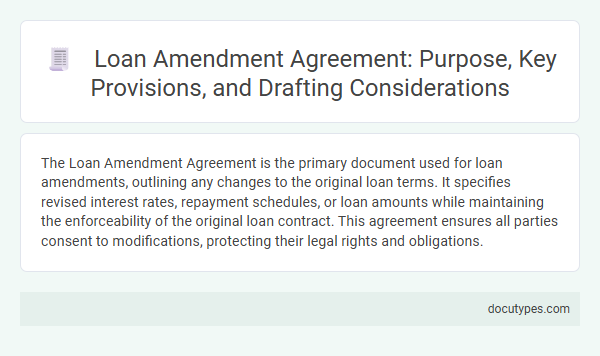The Loan Amendment Agreement is the primary document used for loan amendments, outlining any changes to the original loan terms. It specifies revised interest rates, repayment schedules, or loan amounts while maintaining the enforceability of the original loan contract. This agreement ensures all parties consent to modifications, protecting their legal rights and obligations.
Introduction to Loan Amendment Agreements
Loan amendment agreements are essential documents used to modify the terms of an existing loan without creating a new loan agreement. Understanding which agreement document applies helps you manage loan changes effectively.
- Loan Amendment Agreement - A legal document that details changes to the original loan terms such as interest rates, repayment schedules, or loan amounts.
- Amendment and Restatement Agreement - Combines modifications with a restatement of the entire loan agreement for clarity and updated terms.
- Forbearance Agreement - Documents a temporary suspension or reduction of loan payments under specific conditions to avoid default.
Choosing the correct loan amendment agreement ensures clear, enforceable modifications to your loan contract.
Purpose and Importance of Loan Amendments
Loan amendments require a formal Agreement Document to outline the revised terms between the lender and borrower. This document ensures clarity and legal enforceability of changes made to the original loan contract.
The purpose of loan amendments is to adjust repayment schedules, interest rates, or other loan conditions while maintaining mutual agreement. Your lender uses this document to protect both parties and avoid potential disputes during the loan's lifecycle.
Common Scenarios Requiring Amendments
Loan amendments require a formal agreement document to outline changes to the original terms. The most commonly used document is the Loan Amendment Agreement, which legally modifies the existing loan contract.
Common scenarios requiring amendments include changes in repayment schedules, adjustments to interest rates, or an increase in the loan amount. Your lender will prepare this document to ensure both parties agree on the new conditions.
Key Provisions in Loan Amendment Agreements
Which agreement document is typically used for loan amendments? Loan amendment agreements are formal documents that modify the terms of an existing loan contract. These amendments address changes in interest rates, payment schedules, or loan covenants.
What are the key provisions in loan amendment agreements? Key provisions include the revised loan amount, updated repayment terms, and any changes to collateral or guarantees. The document also specifies the effective date of the amendments and any required borrower or lender consents.
Procedure for Amending Loan Agreements
Loan amendments require a specific agreement document known as the Loan Amendment Agreement. Your lender and you must follow a clear procedure to ensure legal compliance and enforceability.
- Identification of Amendment Terms - The parties agree on the specific changes to the original loan terms, including interest rates, repayment schedules, or collateral adjustments.
- Drafting the Loan Amendment Agreement - A formal document is prepared detailing all modifications and referencing the original loan contract.
- Execution and Documentation - Both parties sign the amendment agreement, which is then attached to the original loan documents for record-keeping and future reference.
Legal and Regulatory Considerations
The Loan Amendment Agreement is the primary document used for modifying the terms of an existing loan. Legal considerations include ensuring compliance with applicable contract laws and lender-borrower obligations. Regulatory factors often require adherence to financial regulations and timely filing with relevant authorities to maintain enforceability.
Essential Steps in Drafting an Amendment
Loan amendments require a clear and precise agreement document to modify the original loan terms effectively. The most commonly used document for such modifications is the Loan Amendment Agreement, which outlines the changes agreed upon by the parties involved.
Drafting a loan amendment involves several essential steps to ensure legal and financial accuracy. First, identify the specific terms of the original loan that need to be changed, such as interest rate, payment schedule, or maturity date. Next, clearly state the revised terms within the amendment document, ensuring consistency and clarity. Finally, include signatures from all parties to validate the amendment and make it legally binding.
Risks and Pitfalls to Avoid
The Loan Amendment Agreement is the primary document used to modify the terms of an existing loan. Risks include unclear language that may lead to disputes or unintended obligations, and failure to obtain proper approvals can invalidate the amendment. Your careful review ensures compliance and protects against future legal pitfalls.
Best Practices for Negotiating Amendments
The Loan Amendment Agreement is the primary document used for modifying the terms of an existing loan. Best practices for negotiating amendments ensure clarity and protect the interests of all parties involved.
- Use a clear and detailed Loan Amendment Agreement - This document precisely outlines the changes to the original loan terms, preventing future disputes.
- Engage in thorough negotiations - Careful discussion helps align the amendment with the current financial conditions and both parties' expectations.
- Review all terms carefully - You must confirm that the amendment reflects agreed changes and complies with governing laws.
Which Agreement Document Is Used for Loan Amendments? Infographic

